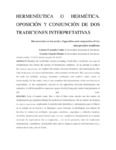
Please use this identifier to cite or link to this item:
http://ricaxcan.uaz.edu.mx/jspui/handle/20.500.11845/881Full metadata record
| DC Field | Value | Language |
|---|---|---|
| dc.contributor | 239594 | es_ES |
| dc.contributor | 434188 | - |
| dc.contributor.other | https://orcid.org/0000-0002-6926-6080 | - |
| dc.contributor.other | https://orcid.org/0000-0002-9907-7539 | - |
| dc.coverage.spatial | Global | es_ES |
| dc.creator | Fernández Galán Montemayor, Carmen | - |
| dc.creator | Lizardo Mendez, Gonzalo | - |
| dc.date.accessioned | 2019-03-27T18:56:48Z | - |
| dc.date.available | 2019-03-27T18:56:48Z | - |
| dc.date.issued | 2012-11 | - |
| dc.identifier | info:eu-repo/semantics/publishedVersion | es_ES |
| dc.identifier.issn | 2254-4496 | es_ES |
| dc.identifier.uri | http://localhost/xmlui/handle/20.500.11845/881 | - |
| dc.identifier.uri | https://doi.org/10.48779/9csq-fh46 | - |
| dc.description | Reading the world like a book or reading a book like a world are two ways of interpretation that permit the tracing of hermeneutic traditions. In an attempt to achieve the conjuctio oppositorum, we explore the tension between hermetics and hermeneutics that forks in the road of science and literature, whose borders are blurred. The ways of revealing the truth are multiple: analogy, metaphor, archetypes and symbols imply routes of intertextuality for the reader, who in turn completes the interpretation in his own horizon of expectations. In the conjunction, and not in the opposition, between hermeneutics and hermetics, it will be possible to open new spaces for the living and creative interpretation of life and texts. | es_ES |
| dc.description.abstract | Leer el mundo como libro o leer el libro como mundo son dos modos de interpretación que permiten dibujar las tradiciones hermenéuticas. En un intento de alcanzar la conjuctio oppositorum, exploramos la tensión entre hermética y hermenéutica que se bifurca en el camino de la ciencia y la literatura, cuyas fronteras se desdibujan. Las formas de desvelar la verdad son múltiples: analogías, metáforas, arquetipos y símbolos implican recorridos intertextuales para el lector que, a su vez, completa la interpretación en su propio horizonte de expectativas. En la conjunción, y no en la oposición, entre las tradiciones hermenéutica y hermética, será posible abrir nuevos espacios para la interpretación viva y creativa de la vida y de los textos. | es_ES |
| dc.language.iso | spa | es_ES |
| dc.publisher | Editorial Delirio | es_ES |
| dc.relation | http://revistacaracteres.net/revista/vol1n2noviembre2012/hermeneutica-o-hermetica-oposicion-y-conjuncion-de-dos-tradiciones-interpretativas/ | es_ES |
| dc.relation.uri | generalPublic | es_ES |
| dc.rights | Atribución-NoComercial-CompartirIgual 3.0 Estados Unidos de América | * |
| dc.rights.uri | http://creativecommons.org/licenses/by-nc-sa/3.0/us/ | * |
| dc.source | Caracteres. Estudios culturales y críticos de la esfera digital, Vol. 1, No. 2, | es_ES |
| dc.subject.classification | CIENCIAS SOCIALES [5] | es_ES |
| dc.subject.other | hermenéutica | es_ES |
| dc.subject.other | hermética | es_ES |
| dc.subject.other | semiosis | es_ES |
| dc.subject.other | interpretación | es_ES |
| dc.subject.other | símbolo | es_ES |
| dc.subject.other | hermeneutics | es_ES |
| dc.subject.other | hermetic | es_ES |
| dc.subject.other | interpretation | es_ES |
| dc.subject.other | symbol | es_ES |
| dc.title | Hermenéutica o hermética. Oposición y conjunción de dos tradiciones e interpretativas | es_ES |
| dc.type | info:eu-repo/semantics/article | es_ES |
| Appears in Collections: | *Documentos Académicos*-- M. en Inv. Humanísticas y Educativas | |
Files in This Item:
| File | Description | Size | Format | |
|---|---|---|---|---|
| HERMENÉUTICA O HERMÉTICA.pdf | 239,79 kB | Adobe PDF |  View/Open |
This item is licensed under a Creative Commons License
